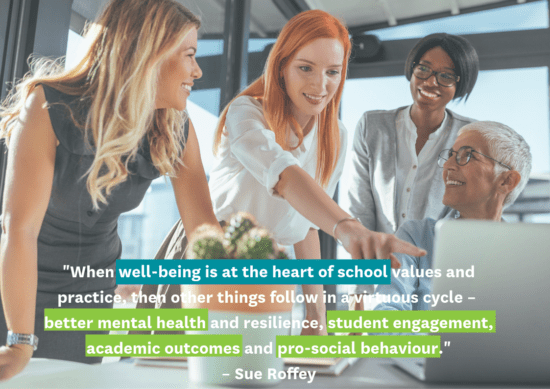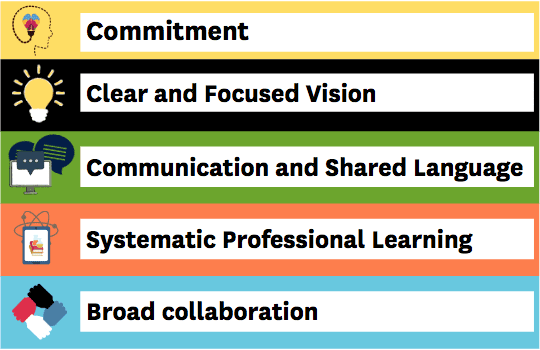What is a healthy workplace in K-12 education?
Learn more about what constitutes a healthy workplace in the K-12 school setting and what conditions within the workplace need to be set to ensure that educators thrive within their roles.
Healthy workplaces that promote mental health and well-being are productive, attract and retain top talent, and get the best out of highly engaged employees. This means better outcomes for the organization’s bottom line, whether that be profits, social impact or – in the case of our public education systems – student outcomes.
While schools and school districts come in all shapes and sizes and differ between provinces and territories, healthy environments for both teaching and learning generally have a few common ingredients.

What is well-being?
“Well-being” is an imperfect term due to its broad coverage across various disciplines including healthcare, economics, and the social sciences, among other disciplines. This makes it difficult to define well-being in simple terms, although it generally refers to “how we are doing” as individuals, communities or society. Most relevant to the workplace is personal or subjective well-being – “life satisfaction based on an individual’s perception of their health, happiness and sense of purpose” – and its interaction with work.¹
In terms of the workplace, the International Labour Organization (ILO) defines well-being as relating “to all aspects of working life, from the quality and safety of the physical environment, to how workers feel about their work, their working environment, the climate at work and work organization.” There is also a trend in companies and organizations prioritizing employee well-being as a way to raise productivity, as well as counteract workplace challenges including stress, bullying, conflict, and mental health problems.²
In brief, while there are numerous factors that can impact a staff member’s sense of personal or subjective well-being, research in positive psychology has identified three key characteristics of a healthy workplace:

A sense of relatedness Means that…
staff have positive relationships with other staff members, feel welcome and included, greet and acknowledge each other daily, and check-in with each other to provide support. When individuals have positive relationships, they are also more sensitive to each other in times of stress.

A Sense of Competency means that…
staff feel that their strengths, skills, and potential are valued, appreciated, and recognized. Unlike workplace gossip or other harmful conversations, shared work goals allow staff to work as a team, to complement each other’s skills, and to contribute to overall team performance.
Autonomy Support means that…
staff feel heard and valued in developing solutions and strategies, find opportunities to collaborate, and seek others’ perspectives. Unlike bullying or other behaviours that belittle, workplaces that practice autonomy support also foster psychological well-being.³
What is mental health?
The World Health Organization (WHO) defines mental health as “a state of well-being in which every individual realizes his or her own potential, can cope with the normal stresses of life, can work productively and fruitfully, and is able to make a contribution to her or his community.”
The WHO also emphasizes in its constitution that “Health is a state of complete physical, mental and social well-being and not merely the absence of disease or infirmity.”⁴
What makes a “good” school culture?
School culture is not a fluffy concept; rather, it is a concept that can be pinpointed, designed, and executed – and school leaders are able to influence school culture where there are strong relationships between every member of the school community. Here are five key elements that shape school culture:
![]() Fundamental Beliefs and Assumptions. Things that staff consider true, such as the belief that “All students have the potential to succeed.”
Fundamental Beliefs and Assumptions. Things that staff consider true, such as the belief that “All students have the potential to succeed.”
![]() Shared Values.Staff judgments about whether something is right or wrong, good or bad, just or unjust, in relation to their fundamental beliefs and assumptions, such as “The right thing is for our teachers to be collaborating with colleagues every step of the way.”
Shared Values.Staff judgments about whether something is right or wrong, good or bad, just or unjust, in relation to their fundamental beliefs and assumptions, such as “The right thing is for our teachers to be collaborating with colleagues every step of the way.”
![]() Norms.How staff believe they should act and behave, or what behaviour they think is expected of them, such as “We should be engaged at our weekly staff meetings.”
Norms.How staff believe they should act and behave, or what behaviour they think is expected of them, such as “We should be engaged at our weekly staff meetings.”
![]() Patterns and Behaviours. How staff actually act and behave at work. In a strong school culture, organizational norms often lineup with how staff act and behave. In a weak culture, staff actions and behaviours may differ from the established norms.
Patterns and Behaviours. How staff actually act and behave at work. In a strong school culture, organizational norms often lineup with how staff act and behave. In a weak culture, staff actions and behaviours may differ from the established norms.
![]() Tangible Evidence. Practical evidence that you can see, feel, and hear that signals to those within the school and beyond what is the school’s culture. For example, a full staff parking lot an hour before school begins.⁵
Tangible Evidence. Practical evidence that you can see, feel, and hear that signals to those within the school and beyond what is the school’s culture. For example, a full staff parking lot an hour before school begins.⁵
What are the top organizational conditions that support staff mental health and well-being?
School Mental Health Ontario outlines the top ten organizational conditions that position schools and school districts to maintain high-quality practices in school mental health and well-being. While these conditions centre around the well-being of students, they can similarly be applied to the well-being of adults working in K-12 education. Some top conditions include:

 Put simply, when senior leaders demonstrate commitment to mental health and well-being, the result is contagious and school staff are also empowered to make this a priority.
Put simply, when senior leaders demonstrate commitment to mental health and well-being, the result is contagious and school staff are also empowered to make this a priority. Collaborating to create a shared vision with staff, key stakeholders, and the community about what well-being looks like helps guide the creation of well-being strategies and decisions that align with staff strengths, needs, and priorities.
Collaborating to create a shared vision with staff, key stakeholders, and the community about what well-being looks like helps guide the creation of well-being strategies and decisions that align with staff strengths, needs, and priorities. Given the complexity of mental health and well-being, it’s important to adopt common terms to build a shared understanding, such as the difference between mental health and mental illness.
Given the complexity of mental health and well-being, it’s important to adopt common terms to build a shared understanding, such as the difference between mental health and mental illness. Ensuring that staff at all levels of the school district receive professional learning about mental health and well-being that is consistent with their role and based on best available evidence. This ensures that all adults are equipped to promote mental health and well-being.
Ensuring that staff at all levels of the school district receive professional learning about mental health and well-being that is consistent with their role and based on best available evidence. This ensures that all adults are equipped to promote mental health and well-being. Realizing that mental health and well-being is an important matter that impacts all staff within a school district – and for which everyone has a role to play – as a step towards building relationships founded on respect, trust, and collaboration among all staff.⁶
Realizing that mental health and well-being is an important matter that impacts all staff within a school district – and for which everyone has a role to play – as a step towards building relationships founded on respect, trust, and collaboration among all staff.⁶
References and further reading
¹ Work and Wellbeing in the 21st Century (via International Journal of Environmental Research and Public Health)
² Workplace well-being (via International Labour Organization)
³ Three key conditions to create a healthy workplace (via The Globe and Mail)
⁴ Mental health: a state of well-being (via World Health Organization)
⁵ What Makes a Good School Culture? It starts with connections — strong and overlapping interactions among all members of the school community (via Usable Knowledge, Harvard Graduate School of Education)
⁶ Planning for Sustainable Practices in School Mental Health and Well-Being: Setting the Stage with the Top 10 Organizational Conditions (via School Mental Health-ASSIST)
See also: Leading Mentally Healthy Schools: A Resource For School Administrators (via School Mental Health-ASSIST)
See also: Positive School Culture and Climate (via Professional Development Service for Teachers, Ireland)
Image Quote: Creative Caring for Teachers: How a whole-school well-being approach can support everyone’s mental health (via Education Canada Magazine)

